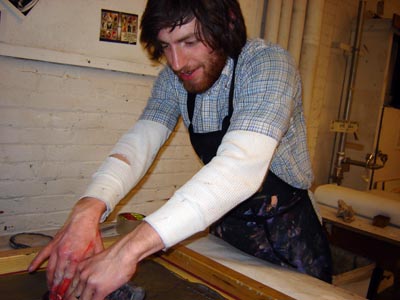
Sports
- The Outdoor Program helps people plan adventures.
- Adam Lake uses fencing to bring people together.
- Win or lose, the Pit Crew keeps Mac Court shaking for the Ducks.
- Tearing at jerseys and slamming into each other. It's women's rugby.
Changes
- A Taiwanese student finds adjusting to a foreign culture challenging.
- A close-up look at the ASUO president.
- A senior's abrupt transition to Eugene after Hurricane Katrina.
Arts
- A ballroom dance club president wears many hats and makes them too.
- Whether composing or jamming on his mandolin, Jesse Jones shares his love of music.
- Non-traditional African dance brings a new sense of community.
- The Student Fibers Guild proves that knitting isn't just for old ladies anymore.
- Halo Jones' music and art expresses his dark and light sides.
- A musician, student, activist and artist.
- For Ashley Maury, jewelry is more than decorative.
- A student TV show features news, sports, drama and comedy.
- A printmaking student goes beyond the studio and into the city.

UO printmaking student goes beyond the studio and into the city.
By Emily Cable
As he sits down at Espresso Roma, Brendan Newell asks, “Can I draw while we do this?” He opens his black notebook about midway and spends the whole interview doodling and sketching. He dedicates at least an hour a day to his sketchbook, and when he has an actual project he’s working on, a lot more, he says. For Newell, a good reason to draw ranges from an upcoming project to boredom. “This morning, we had a critique and I was really bored, so I drew... I didn’t have any colors but I had coffee, so you can just do watercolor with the coffee,” he explains about the brown coloring in one of his drawings. Art is a constant presence in Newell’s life.

Brendan Newell pulls paint toward himself on a silk screen. He is working on a series of prints of robot prom dates. |
This 21-year-old fourth year printmaking art student looks the part. Newell’s hands are semi-permanently stained black, much like the hands of a mechanic, from paint and etching ink. His pants and sweatshirt have splatters of paint, remnants of his days as a painting major before he made the switch to print. He even asks at one point whether the shoulder of his jacket still looked wet, because he had earlier spilled mineral spirits, a chemical similar to paint thinner, on it. The only article of clothing he has that isn’t someway stained by his various art projects is his nice suit.
Newell will be done with his undergraduate degree in printmaking with a minor in multimedia design by the end of spring term 2006, but he is applying to become a Bachelor of Fine Arts (BFA) student. The difference between a BA in art and a BFA is an extra year where the artist has only studio classes with a specific focus in art. Newell has been an art student for the past two years, only switching from painting to printmaking last term. “We’re not getting along very well right now, me and the paint,” he says. “I stopped being able to bring ideas to fruition in painting. It’s very frustrating and it made me unhappy. Thus defeating the whole selfish purpose of why I started doing my art major.”
It’s easy for non-art majors to assume that art students don’t do any “real” work and just get to go have fun playing with their art supplies. On the contrary, art students put in hours of work. For example, with three weeks left in winter term, Newell has done the math (yes, art students can do math) and figured that he has 13 hours worth of work to do every day, weekends included, to finish his projects by the end of the term.
Newell’s current projects are silk-screening and etching. There are two parts to any project he does. The first is developing the image by drawing and designing the layout for how he wants he final image to look. “Everything pretty much revolves around drawing, for the most part, at least printing and painting do.” After that development is done, Newell sets up the image on a screen or copper, completing numerous intricate steps to make sure the image transfers correctly.

Presented with a cabinet full of silkscreen paint, Newell contemplates which color to use next. |
Newell’s interest in art surfaced when he was a child and would try to draw characters from comic books. In middle school, his interest veered to street art. “I really want to learn how to draw graffiti characters,” he said, so as a teenager he went to the Portland State University Library and checked out Subway Art, “the quintessential old school graffiti book,” Newell says. “Then I got the documentary Style Wars and watched that a couple hundred times.”
After he finishes his BFA next year, Newell plans to take a break from school before possibly returning to
graduate school. He wants to work in either design or advertising.
